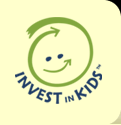Intellectual Development means being able to communicate, to think both creatively and abstractly, to pay attention, solve problems, and develop keen judgment and a lifelong readiness to learn.
|
Parents Can: Sing number songs any time when walking, driving or just cuddling together, for example, "One, two, buckle my shoe" or "Five little monkeys" | Child Will: Hear the order of numbers and may in "toddler-talk" try to imitate the songs and the order of numbers usedBegin to explore the use of numbers by imitating counting, although the numbers may not be in the correct order
| |
Parents Can: Use any opportunity during bath or play time to count eyes, ears, nose, mouth, fingers and toes | Child Will: Begin to understand quantity as it relates to her own bodyHear the name of the body part reinforcedDevelop a strong sense of self-identity
| |
Parents Can: Use numbers to involve their toddler in daily routines, such as counting the number of place settings or plates while setting the table | Child Will: Feel he can contribute and make a difference in the family's routinesFeel a sense of belonging and a part of the familyFeel confident about using numbers (even if they are used incorrectly)
|
| | |
Parents Can: Use numbers and counting during any kind of play (for example, with blocks or dolls) in which things can be counted | Child Will: Begin to imitate how you use numbers to make her feel "grown up"Begin to practice counting common objects on her own, such as cars and toys
| |
Parents Can: Use stickers and arts and craft materials to count and sort, according to colour or shape, while making pictures and designs | Child Will: Experiment with combinations of shapes and coloursExplore the notion of same and differentBecome familiar with quantity, often mimicking the numbers adults say
| |
Parents Can: Use household items like spoons, plastic containers and bowls to demonstrate and practice the concept of grouping and sorting | Child Will: Begin to demonstrate a basic understanding of groups (Your toddler may initially group all things with wheels as one group, and all animals as another group. For example, all animals may be called "cows.")May begin to ask questions about the qualities of objects in a group
|
| | |
Parents Can: Use routines as an opportunity to count and use numbers. For example, "First we get dressed, second we eat breakfast" | Child Will: May attempt to imitate number sequencesBegin to understand sequences of eventsBegin to talk about sequences of events and routines
| |
Parents Can: Share books with their toddler that illustrate numbers and representation of quantity | Child Will: Begin to explore the concept of a symbol representing a quantityLook at counting books and imitate the counting of objects or pagesRandomly count while playing (Your toddler may not actually be counting, but will be repeating a sequence of numbers.)
| |
Parents Can: Point out numbers and provide their name | Child Will: Begin to understand that a symbol represents the number they talk and sing aboutPretend to print numbers, which usually winds up as scribbles
| |
Parents Can: Compare common things by size using the words "big" and "small" to describe them | Child Will: Begin to recognize differences in size (small to big)
|
| |
|
